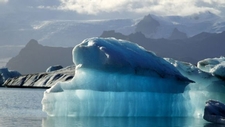Water Cycle
Supporting

TEKS Objective
The student is expected to describe and illustrate the continuous movement of water above and on the surface of Earth through the water cycle and explain the role of the Sun as a major source of energy in this process.
Essential Understanding
The student knows that there are recognizable patterns in the natural world and among the Sun, Earth, and Moon system.
Science Background
The Water Cycle: US Geological Survey (website) - Graphic illustrates the water cycle and how it is driven by energy from the Sun. Includes links to detailed information about all aspects of the water cycle.
The Water Cycle
US Geological Survey, Georgia Water Science for Schools, water.usgs.gov/edu
Signature Lesson
The Water Cycle: Science NetLinks (website) - Students describe, model and illustrate the processes of the water cycle while learning that the water cycle is continuous, that water changes form at different points of the cycle, and that processes of the water cycle affect Earth’s land, oceans and atmosphere.
- Supporting Lessons
- Extensions
- Assessment Ideas
- Literature Connections
- Related
TEKS - Additional Resources
Supporting Lessons
Make a Water Cycle Wristband: American Chemical Society (PDF) - Students create wristbands from colored beads to remember each stage of the water cycle.
Make a Water Cycle Wristband
American Chemical Society, portal.acs.org
What is the Water Cycle? BioEd Online (website) - Students build, observe and discuss a simple model of the water cycle. Teacher background information included.
What is the Water Cycle?
BioEd Online, www.bioedonline.org
The Water Cycle: K6edu.com (website) - Students will discover the various ways water moves around Earth as part of the water cycle.
Water Cycle Game: NOAA (PDF) - Students learn how waters moves through the water cycle, and they identify the states of water and changes in state as it moves through the water cycle.
Water Cycle Game
NOAA, www.noaa.gov
Water Planet/Water Cycle: FOSSWeb (website) - This module explores the water cycle through an interactive game. Before starting, download the game's activity sheet.
Elaboration Lessons and Extensions
The Water Cycle: Science for Ohio (website) - In this unit of five activities, students work in teams to create water cycle models, use Internet resources to learn water cycle concepts, learn the major locations of water on Earth, and explore the effects of pollution in the water.
The Water Cycle
Miami University, Science for Ohio, www.cas.miamioh.edu
The Water Cycle: Montana State University Department of Mathematical Sciences (website) - This unit is designed to create an awareness of water and its uses, and to develop students’ understanding of water’s importance to, and impact on life. Specific topics covered include where water is found, the movement of water from one part of the hydrosphere to another, water quality and conservation.
The Water Cycle
Montana State University Department of Mathematical Sciences, www.math.montana.edu
Assessment Ideas
Divide the class into seven groups, each representing one key element of the water cycle: precipitation, infiltration, ground water, water table, evaporation, transpiration and water vapor. Hand out poster paper and crayons or markers, and have each group draw a picture illustrating how their process works within the water cycle. Instruct students to use their notes and previous lessons as resources. When they have finished, have teams arrange their posters on the wall in the correct order, starting with precipitation. Ask each team to explain its part in the process, and then lead a class discussion, supported by students’ water cycle models or real-world examples.
Literature Connections
Drip! Drop! How Water Gets to Your Tap. Seuling, Barbara (ISBN-13: 978-0823414598)
A Drop Around the World. Shaw-McKinney, Barbara (ISBN-13: 978-1883220723)
Oceans. Simon, Seymour (ISBN-13: 978-0060889999)
Water. Flanagan, Alice (ISBN-13: 978-0756500382)
Water. Ditchfield C., Jenner J. and Vargus NR. (ISBN-13: 978-0516293691)
Water, Water Everywhere. Rauzon MJ and Overbeck-Bix C. (ISBN-13: 978-0871563835)
Bringing the Rain to Kapiti Plain. Aardema, Verna (ISBN-13: 978-0140546163)
This Is the Ocean. Hamilton, Kersten (ISBN-13: 978-1563978906)
Water Dance. Locker, Thomas (ISBN-13: 978-0152163969)
El Ciclo del Agua/The Water Cycle. Frost, Helen [Author] and Guzman Ferrer, Martin Luis [Translator] (ISBN-13: 978-0736823142)
Additional Resources
Follow a Drop Through the Water Cycle: US Geological Survey (website) - Explains the water cycle by following a single drop of water through all different parts of the cycle.
Water Cycle Animation: Exploring Earth (website) - Observe a raindrop traveling through the water cycle.
TEKS Navigation
Grade 4
Need Assistance?
If you need help or have a question please use the links below to help resolve your problem.

Comments